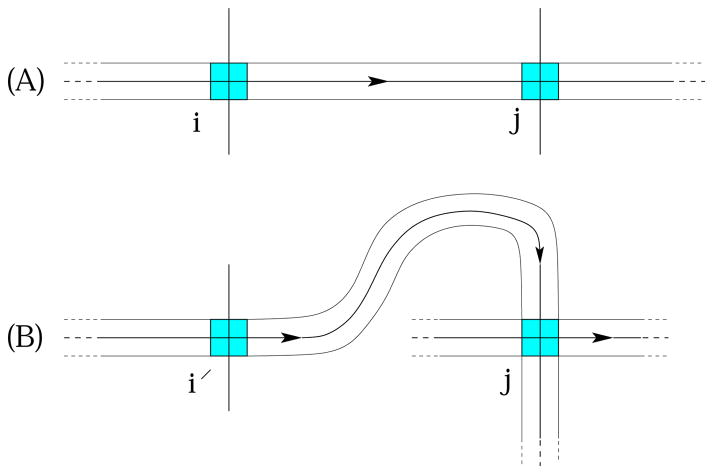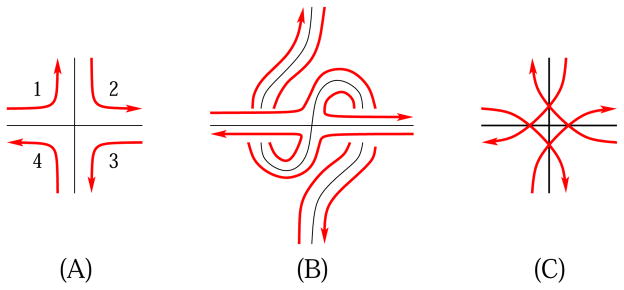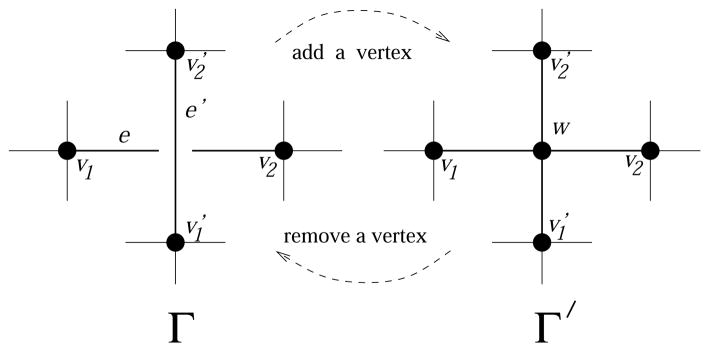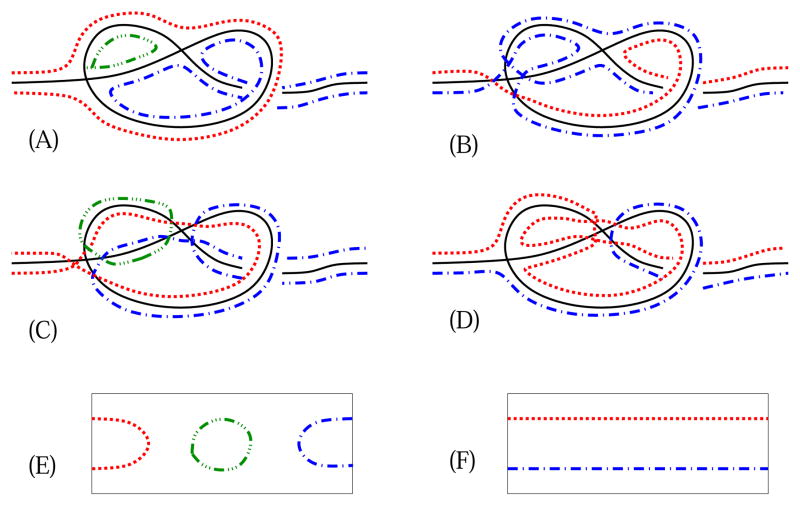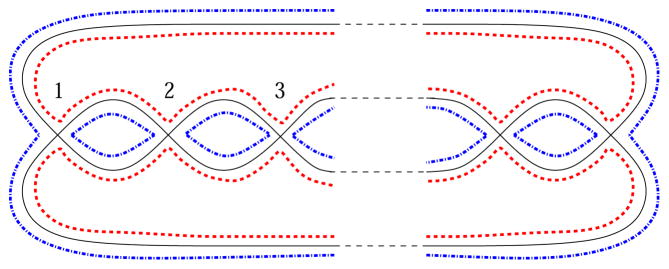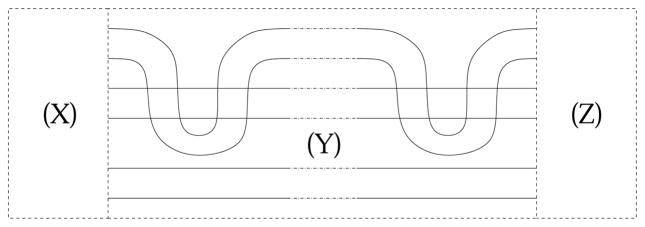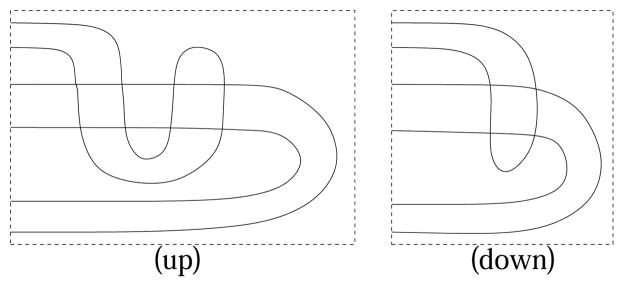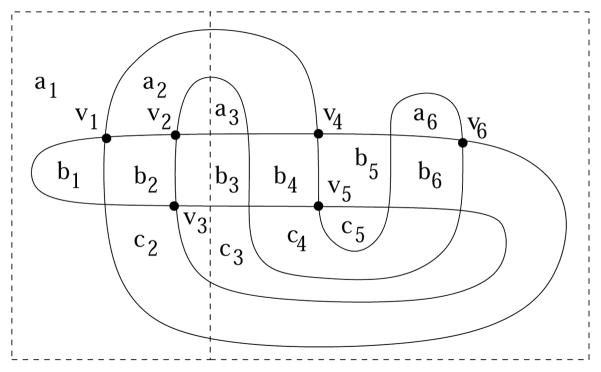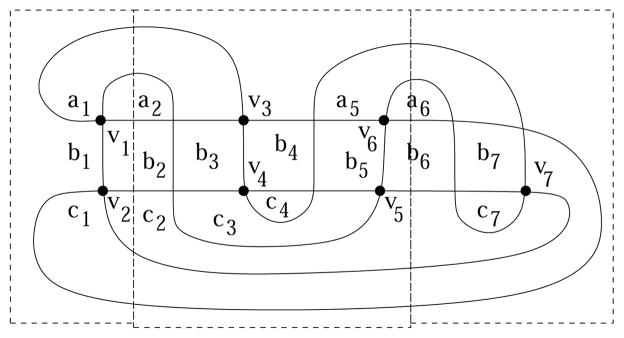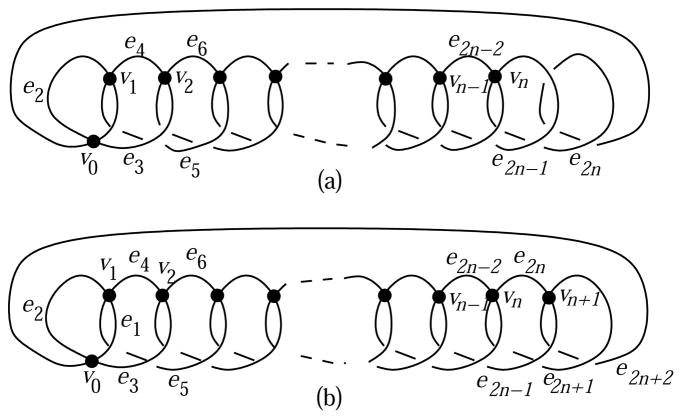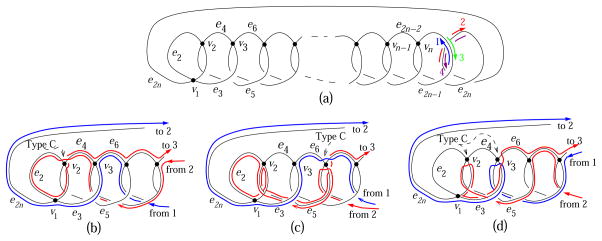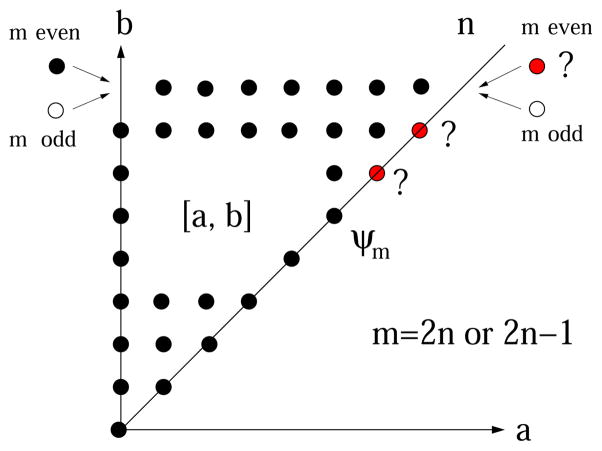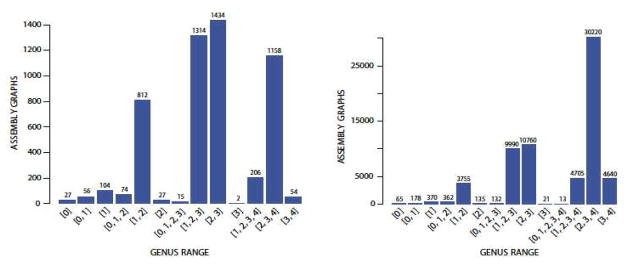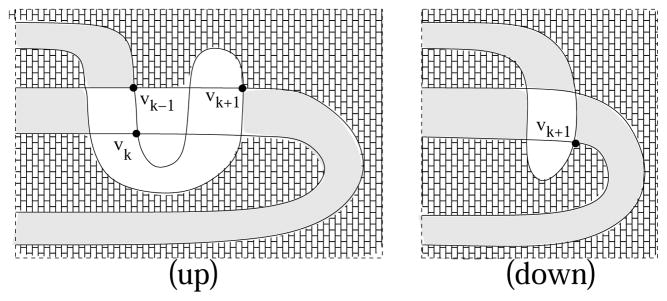Abstract
A rigid vertex of a graph is one that has a prescribed cyclic order of its incident edges. We study orientable genus ranges of 4-regular rigid vertex graphs. The (orientable) genus range is a set of genera values over all orientable surfaces into which a graph is embedded cellularly, and the embeddings of rigid vertex graphs are required to preserve the prescribed cyclic order of incident edges at every vertex. The genus ranges of 4-regular rigid vertex graphs are sets of consecutive integers, and we address two questions: which intervals of integers appear as genus ranges of such graphs, and what types of graphs realize a given genus range. For graphs with 2n vertices (n > 1), we prove that all intervals [a, b] for all a < b ≤ n, and singletons [h, h] for some h ≤ n, are realized as genus ranges. For graphs with 2n − 1 vertices (n ≥ 1), we prove that all intervals [a, b] for all a < b ≤ n except [0, n], and [h, h] for some h ≤ n, are realized as genus ranges. We also provide constructions of graphs that realize these ranges.
Keywords: Four-regular rigid vertex graphs, realization of genus ranges, unsigned Gauss codes
1 Introduction
A rigid vertex in a graph is a vertex with a prescribed cyclic order (called a rotation system) of its incident edges. We consider embeddings of 4-regular rigid vertex graphs in orientable surfaces. The notion of 4-regular rigid vertex graphs have been studied extensively in knot theory in various contexts. For example, they can be seen as virtual link projections [16]. When a 4-regular rigid vertex graph corresponds to a virtual knot projection (i.e., the image of a single circle), it is called transversely connected. In this case, it is described by a double occurrence word (in which each letter appears twice), known as an (unsigned) Gauss code. Transversely connected 4-regular rigid vertex graphs in space are also called singular knots (e.g., [4]). An embedding of a 4-regular rigid vertex graph in a surface is required to preserve the given cyclic order of edges at every vertex. The minimum genus of virtual knots have been studied [5, 13], and the genus range of diagrams corresponding to a given Gauss code is of interest in knot theory. For example, necessary and sufficient conditions for the planarity of graphs represented by Gauss codes are given in [7, 8], which in turn plays a key role in making knot tables.
Graphs with 4-valent rigid vertices and end points, called assembly graphs, have been also used to model DNA rearrangements, in which each 4-valent vertex represents a recombination site [3, 2]. Spatial embeddings of these graphs could be seen as a physical representations of the molecules at the moment of rearrangement, and it is of interest to study certain combinatorial properties and embeddings of a given graph that reflect questions from such biological processes. Genera of these graphs may measure their spatial complexity.
The genus of a graph (also known as minimum genus) is a well-known notion in topological graph theory, and has been studied for a variety of ordinary (non-rigid vertex) graphs (e.g., [17, 14]). It represents the minimum genus of a surface in which the graph can be embedded. The orientable genus range of a given graph is the set of all possible genera of orientable surfaces in which the graph can be embedded cellularly (where the complement consists of open disks). There is a one-to-one correspondence between cellular embeddings of graphs in oriented surfaces and rotation systems, that specify cyclic orders (rotation schemes) of edges at each vertex [17]. In this paper we study the genus ranges of transversely connected 4-regular rigid vertex graphs. A cellular embedding of a 4-regular rigid vertex graph in an orientable closed surface corresponds to specifying a set of two rotation schemes at each vertex, one being the reverse of the other, while the genus ranges for ordinary graphs consider all possible rotation schemes at every vertex. Since any embedding of rigid vertex graphs must preserve the fixed ordering of incident edges to each vertex, their genus ranges are more restricted, compared to those of ordinary (non-rigid vertex) graphs. For example, the graphs Γ and Γ′ depicted in Figure 1 are isomorphic as graphs, but not isomorphic as rigid vertex graphs. At the vertex v in Γ, the cyclic order of edges (a, b, c, d) in counter-clockwise is changed to an inequivalent cyclic order (a, c, b, d) at the corresponding vertex v′ in Γ′. The genus range of Γ and Γ′, as ordinary graphs, is {0, 1, 2} and as rigid vertex graphs, are {1} and {0, 1}, respectively. Hence, results on the genus for ordinary graphs may not be directly applicable to rigid-vertex graphs. Thus in this paper we study the genus ranges of 4-regular rigid vertex graphs. Other variations of restricted graph embeddings in surfaces have been studied in the literature. In [18], for example, embeddings of graphs in orientable surfaces with respect to a certain set of walks was defined. In our context, a walk corresponds to the boundary curve of a face of the complement.
Figure 1.
Difference of genera between regular graphs and rigid vertex graphs
We set forth the following two problems.
Problem 1
For a positive integer n, what sets of integers do or do not appear as genus ranges of 4-regular rigid vertex graphs with n vertices?
Identify the class of 4-regular rigid vertex graphs with a given genus range.
With this paper we provide some answers to these questions. In particular, we observe that a genus range of a 4-regular rigid vertex graph is always a set of consecutive integers (Lemma 4). This result is known [12] for general graphs up to graph equivalence, but it is a new observation for rigid vertex graphs. Further, we show (Theorem 32) that every set {m, m + 1, …, m′} for 0 ≤ m < m′ ≤ n appears as a genus range of some transversely connected 4-regular rigid vertex graph with 2n vertices. The same family, without the set {0, 1, …, n}, appears as a genus range of some transversely connected 4-regular rigid vertex graph with 2n − 1 vertices. We also observe that none of such graphs with 2n − 1 vertices has genus range {0, …, n} (Lemma 16) nor genus range {n} (Lemma 18). We characterize those graphs with genus range {0} (Proposition 20). For a given number n, even or odd, we leave it open to determine the numbers h such that the set {h} appears as a genus range of a transversely connected 4-regular rigid vertex graph of n vertices.
The paper is organized as follows. In the rest of this section we define transversely connected 4-regular rigid vertex graphs, the genus range of these graphs and introduce several useful constructions. In Section 2 we discuss and prove general observations about properties of genus ranges of these graphs motivated by the computational studies in Table 1. In Section 3 we prove the existence of certain genus ranges in their most general form, and in Section 4, we investigate which intervals of integers appear as genus ranges. We conclude with remarks on distributions of genus ranges.
Table 1.
Computer calculations of possible genus ranges of graphs with n vertices.
| 𝒢ℛn : | |
| n = 2 | {0}, {1}. |
| n = 3 | {0}, {1}, {0, 1}, {1, 2}. |
| n = 4 | {0}, {1}, {0, 1}, {1, 2}, {0, 1, 2}. |
| n = 5 | {0}, {1}, {2}, {0, 1}, {1, 2}, {2, 3}, {0, 1, 2}, {1, 2, 3}. |
| n = 6 | {0}, {1}, {2}, {3}, {0, 1}, {1, 2}, {2, 3}, {0, 1, 2}, {1, 2, 3}, {0, 1, 2, 3}. |
| n = 7 | {0}, {1}, {2}, {3}, {0, 1}, {1, 2}, {2, 3}, {3, 4}, {0, 1, 2}, {1, 2, 3}, {2, 3, 4}, {0, 1, 2, 3}, {1, 2, 3, 4}. |
1.1 Terminology
In this section we define the concepts we use in the paper, and introduce constructions that will be used in later sections to find various genus ranges.
1.1.1 Four-regular rigid vertex graphs and double occurrence words
A rigid vertex is a vertex for which a cyclic order (or its reverse) of its incident edges is specified. For a rigid vertex that has 4 incident edges, if its incident edges appear in order (e1, e2, e3, e4), then the corresponding rotation schemes specified at this vertex are cyclic permutations of (e1, e2, e3, e4) and cyclic permutations of its reverse (e4, e3, e2, e1). For the ordered edges (e1, e2, e3, e4), we say that e2 and e4 are neighbors of e1 and e3 with respect to v. The neighboring edges are consecutive with respect to all rotation schemes assigned to the vertex. We observe that valency 4 is the smallest valency that makes difference in cyclic ordering of edges and we concentrate here on 4-valent vertices only. Two 4-regular rigid vertex graphs are isomorphic if they are isomorphic as graphs and the graph isomorphism preserves the cyclic order of the edges incident to a vertex.
A trail (a closed walk with no edge repetition) in a graph is called a transverse path, or simply a transversal, if consecutive edges of the path are never neighbors with respect to their common incident vertex. For 4-regular rigid vertex graphs, a transversal is considered as the image of a circle in the graph that goes through every vertex “straight ahead”, and takes non-consecutive edges with respect to the rotation schemes of each vertex. A 4-regular rigid vertex graph that has an Eulerian (visiting all edges) transversal is called a transversely connected 4-regular rigid vertex graph. For a transversely connected 4-regular rigid vertex graph, if a transversal is oriented, the graph is called oriented. We note that in a transversely connected 4-regular rigid vertex graph, if a vertex v is an endpoint of a loop e, then e must be a neighbor of itself.
Convention
In the rest of the paper, unless otherwise stated, all graphs are transversely connected 4-regular rigid vertex graphs.
A double-occurrence word w over an alphabet set is a word which contains each symbol of the alphabet set exactly 0 or 2 times. (Double-occurrence words are also called (unsigned) Gauss codes in knot theory [16].)
Two double-occurrence words are called equivalent if one is obtained from the other by a sequence of the following three operations: (1) (bijective) renaming of the symbols, (2) a cyclic permutation, (3) taking the reverse (e.g., the reverse of w = a1 ⋯ak is wR = ak ⋯a1). For example, w = 123231 is equivalent to its reverse wR = 132321 and w′ = 213132 is equivalent to w by renaming 1 with 2 and 2 with 1.
Double-occurrence words are related to graphs as follows. Let Γ be a transversely connected 4-regular rigid vertex graph. Orient the graph and pick a base point on the graph. Let α = v0, e0, …, vn, en, v0 be an Eulerian transversal starting at the base point and let w = v0 ⋯vn be the sequences of consecutive vertices in α. Each vertex appears twice in w, therefore w is a double-occurrence word over the alphabet consisting of the set of vertices, corresponding to the graph Γ. Conversely, for a given double-occurrence word containing n letters, a graph is constructed as follows. The set of vertices corresponds to the set of distinct symbols in the double-occurrence word, and each vertex is labeled by a symbol. Starting from the vertex labeled by the first symbol of the given word, connect the vertices by edges in the order of appearance of symbols of the word through a Eulerian transversal, and connect the path back to the starting vertex. In the second encounter of a vertex, corresponding to the second appearance of the symbol in the word, the path goes straight through the vertex, so that the edges added in the second visit are not neighbors at that vertex. This results in a transversely connected 4-regular rigid vertex graph.
Equivalence classes of double-occurrence words are in one-to-one correspondence with isomorphism classes of transversely connected 4-regular rigid vertex graphs [2]. In particular, if w is a double-occurrence word, we write Γw for a graph corresponding to w.
1.1.2 Genus of transversely connected 4-regular rigid vertex graphs
An embedding of a graph in a surface is called cellular if each component of the complement of the graph in the surface is an open disk. For a graph G, the minimum orientable genus of G, denoted gmin(G), is the smallest non-negative integer g such that G admits an embedding in a closed (compact, without boundary) orientable surface F of genus g. We recall the following fact (Proposition 3.4.1 in [17]): Every embedding of G into a minimum genus surface is cellular. The maximum orientable genus of G, denoted gmax(G), is the largest non-negative integer g such that G admits a cellular embedding in a closed orientable surface F of genus g.
An embedding of a 4-regular rigid vertex graph in a surface is an embedding of the graph such that the cyclic order of edges at each vertex agrees with those of the corresponding embedded images. In particular, neighboring edges at a vertex belong to the boundary of a common complementary region.
Definition 2
The genus range gr(Γ) of a 4-regular rigid vertex graph Γ is the set of values of genera over all orientable surfaces F into which Γ is embedded cellularly. We denote the family of all genus ranges of graphs with n vertices by 𝒢ℛn.
Convention
In this work, every embedding of a graph is a cellular embedding in an orientable surface.
1.2 Preliminary constructions
In this section we introduce tools to study genus ranges. We describe an explicit construction of a cellular embedding of a graph, related to rotation systems of embeddings of standard graphs [17, 15, 11], called the ribbon graph construction. We also introduce two techniques that are used to calculate genus ranges in later sections: a connection change in Section 1.2.2 and the addition and removal of a vertex in Section 1.2.3. Finally, we observe that genus ranges of graphs consist of consecutive integers in Lemma 4.
1.2.1 Ribbon graph construction
One way to obtain a cellular embedding of a graph Γ in a compact orientable surface is by constructing a surface by connecting bands (ribbons) along the graph. This construction is called a ribbon construction and is described below.
Let Γ be a graph with n vertices labeled from 1 to n, and let w be the double-occurrence word that represents Γ with respect to a transversal. To each vertex i, i = 1, …, n, we associate a square whose center axes coincide with the edges incident to the vertex as depicted in Figure 2. The bands are attached in such a way that the resulting surface is orientable. In Figure 2(A), the connection by a band is described when the vertex j immediately follows i in w, where j is the first occurrence in w. In Figure 2(B), one possibility of connecting a band to the vertex j at its second occurrence is shown. By continuing the band attachment along a transversal, one obtains a compact surface with boundary which consists of finitely many circles. The resulting surface is called a ribbon graph. The ribbon graphs have been studied in literature for general graphs (see, for example, [11]).
Figure 2.
Ribbon graph construction for w = u1iju2i′ju3
By capping the boundaries of a ribbon surface with disks, one obtains a cellular embedding of Γ in an orientable, closed (without boundary) surface. On the other hand, for a given cellular embedding of a graph Γ, its neighborhood is regarded as a ribbon surface as described above. Therefore, a ribbon surface gives rise to an embedding, and any embedding of a graph in an orientable surface corresponds to a ribbon surface.
Note that there are two choices in connecting a band to a vertex j at its second occurrence, either from the top as in Figure 2(B), or from the bottom. Hence 2n ribbon graphs can be constructed, some of which may be homeomorphic. In [7, 8], the two possibilities of connecting bands are represented by signs (±), and signed Gauss codes were used to specify the two choices.
1.2.2 Connection change
The genus range of a given graph can be computed by finding genera of all surfaces constructed from the ribbon graph construction. We recall the well-known Euler characteristic formula, establishing the relation between the genus and the number of boundary components. The Euler characteristic χ(F) of a compact orientable surface F of genus g(F) and the number of boundary components b(F) are related by χ(F) = 2−2g(F)−b(F). As a complex, Γ is regarded as a 1-complex with n vertices and 2n edges, and F is homotopic to such a 1-complex (as a deformation retract). Hence χ(F) = n − 2n = −n. Thus we obtain the following well known formula, which we state as a lemma, as we use it often in this paper.
Lemma 3
Let F be a surface for a graph Γ obtained by the ribbon graph construction. Let g(F) be the genus of F, b(F) be the number of boundary components of F, and n be the number of vertices of Γ. Then we have g(F) = (1/2)(n − b(F) + 2).
Therefore the genus range of the graph Γ can be computed from the numbers of boundary components of all ribbon graphs of Γ, {b(F)|F is a ribbon graph of Γ}. Note that n and b(F) have the same parity, as genera are integers.
In Figure 3(A) and (B), the boundary curves of a ribbon graph of a graph, near a vertex, are indicated. The arrows of these boundary curves indicate orientations of the boundary components induced from a chosen orientation of the ribbon graph. If in Figure 2(B), the direction of entering the vertex has been changed from top to bottom (or vise versa), the ribbon graph may change. This change in the ribbon graph is illustrated in Figure 3(B). Note that the new ribbon graph is also orientable, as indicated by the arrows on the new boundary components. We use a schematic image in Figure 3(C) to indicate the changes of connections of the boundary components illustrated in Figure 3(B). We call this operation a connection change. This corresponds to changing a rotation scheme at the vertex to its reverse. Thus starting from one ribbon graph for a given graph Γ, one obtains its genus range by computing the number of boundary components for the surfaces obtained by switching connections at every vertex (2n possibilities for a graph with n vertices, for a positive integer n).
Figure 3.
Changing the connection (rotation scheme) at a vertex
The following is known for ordinary graphs, and it can be confirmed for rigid vertex graphs by observing that the number of boundary components changes by at most two by a change of connection at a vertex. Similar results have been obtained in other restricted graph embeddings as well (e.g., [18]).
Lemma 4
The genus range of any 4-regular rigid vertex graph consists of consecutive integers.
Hence, from now on the genus range {a, …, b}, for integers 0 ≤ a ≤ b, is denoted by [a, b].
1.2.3 Addition and removal of a vertex
We investigate how the number of boundary components changes under a construction that generates a graph with n ± 1 vertices from one that has n vertices.
Let Γ be a graph and e, e′ be two edges in Γ with endpoints v1, v2 and respectively. We say that Γ′ is obtained from Γ by addition of a vertex by crossing e, e′ and splitting e into e1, e2 and e′ into in cyclic order e1, , e2, (or simply by addition of a vertex when context allows) if Γ′ is obtained from Γ as depicted in Figure 4 and denote it by Γ′ = Γ(e, e′). In this case we also say that Γ is obtained from Γ (e, e′) by vertex removal. Note that the vertices v1, v2, need not to be distinct.
Figure 4.
Addition and removal of a vertex
Let F be a ribbon graph of Γ and let Γ′ be obtained from Γ by addition of a vertex w. A ribbon graph F′ of Γ′ whose boundary connections at every vertex v ≠ w is the same as the boundary connections of F at v is denoted F (w). Since there are two possible connections of the boundary components of F (w) at the new vertex w, the notation indicates one of those two choices.
All possible changes in the global connections of boundary components of F (w) at the new vertex w relative to the boundary components of the crossing edges that add the new vertex w are depicted in Figure 5.
Figure 5.
Possibilities of connections
Definition 5
We say that the boundary component δ of a ribbon graph Γ traces the edge e of Γ if the boundary of the ribbon that contains e is a portion of δ.
There are at most two boundary components that can trace an edge, so there are at most four boundary components of a ribbon graph that trace two edges from Γ.
Lemma 6
Let Γ, Γ′ be two graphs such that Γ′ = Γ (e, e′) by crossing edges e, e′ and addition of a new vertex w. Suppose F and F (w) are ribbon graphs for Γ, Γ′ as defined above with b, b′ being the number of boundary components for F and F (w), respectively. Then we have the following:
If both e and e′ are traced by only one boundary component in F, then b′ = b + 1 or b′ = b + 3.
If both e and e′ are traced by two boundary components in F, then b′ = b + 1 or b′ = b − 1.
If e and e′ are traced by three boundary components in F, then b′ = b − 1.
If e and e′ are traced by four boundary components in F, then b′ = b − 3.
Proof
The proof follows directly from the observations shown in Figure 5.
2 Properties of Genus Ranges
In this section we investigate properties of genus ranges that are used in later sections. Although the following lemma is a special case of Lemma 12, we state it separately since its simple form is convenient to use. We recall that all graphs are transversely connected 4-regular rigid vertex graphs.
Lemma 7
For any double-occurrence word w, the genus range of Γw is equal to that of Γw′ where w′ = waa and a is a letter that does not appear in w.
Proof
The graph Γw′ corresponding to w′ is obtained from the graph Γw by adding a loop with a single vertex corresponding to the letter a. Both of the two boundary connections at the added vertex a increase the number of boundary components by one as depicted in Figure 5 (b) and (h). Hence the genus range remains unchanged.
Definition 8
A double-occurrence word v is said to be obtained from w by loop nesting if there exists a sequence of double-occurrence words w = w0, w1, …, wn = v such that where is a cyclic permutation or reverse of wi and ai is a single letter that does not appear in wi for i = 0, …, n − 1. A double-occurrence word obtained from the empty word ε by loop nesting is called loop-nested. A 4-regular rigid vertex graph corresponding to a loop-nested double-occurrence word is called a loop-nested graph.
Lemma 7 implies that loop nesting preserves the genus ranges. Specifically,
Corollary 9
If a double-occurrence word w′ is obtained from a double-occurrence word w by loop nesting, then their corresponding graphs have the same genus range.
Corollary 10
If a set A appears as the genus range in 𝒢ℛn for a positive integer n, then A appears as a genus range in 𝒢ℛm for any integer m > n.
Proof
Let w′ = wa1a1a2a2 ⋯akak where k = m − n > 0, then by Corollary 9 Γw′ has the same genus range as Γw.
Definition 11
Let Γ1 and Γ2 be graphs and ei be an edge in Γi for i = 1, 2. A graph Γ is said to be obtained from Γ1 and Γ2 by a cross sum with respect to e1 and e2 if it is formed by connecting Γ1 and Γ2 through a new vertex to form the figure-eight graph with e1 and e2, as depicted in Figure 6. The crossing at the middle in the right of Figure 6 is the newly added vertex.
Figure 6.
Cross sum
The cross sum was discussed, in relation to virtual knots, in [10]. The cross sum construction depends on the choice of edges of the two graphs to connect to the figure-eight.
Lemma 12
Let Γ1 and Γ2 be graphs. If Γ is obtained from Γ1 and Γ2 by a cross sum, then gr(Γ) = { g1 + g2 | g1 ∈ gr(Γ1), g2 ∈ gr(Γ2)}.
Proof
Let Γ be the graph obtained from Γ1 and Γ2 by cross sum through e1 and e2. For given ribbon graphs F1 and F2 of Γ1 and Γ2, respectively, a ribbon graph F of Γ is constructed as depicted in Figure 7. The two boundary curves tracing the edges ei of Γi (i = 1, 2) belong to either one component or two in each of F1 and F2. In Figure 7(A), the case where the two curves belong to one component for both Γi, i = 1, 2, is depicted. In (B), the case when one of the two edges is traced by distinct components (Γ2 in this figure) is depicted, and in (C), the case when the both edges are traced by distinct components of Fi, i = 1, 2, is depicted. From the figures we identify these cases (A), (B), (C) with the connection cases (a), (b) and (h), respectively, in Figure 11. We see from Figure 11 that by a connection change in all these cases, the number of boundary components does not change. Let vi and bi be the numbers of vertices and boundary components of Fi, i = 1, 2, respectively, and similarly v, b for F. Then for all cases (A), (B) and (C) we have v = v1 + v2 + 1 and b = b1 + b2 − 1. From Lemma 3 we compute
Figure 7.
Boundary curves of a cross sum construction
Figure 11.
Possibilities of connections
as desired.
Definition 13
Let Γ be a graph, Γ0 be the graph corresponding to the word 1212, and Γ′ be the graph obtained by connecting an edge e of Γ with Γ0 as depicted in Figure 8. Then Γ′ is said to have been obtained by connecting a pretzel to Γ.
Figure 8.
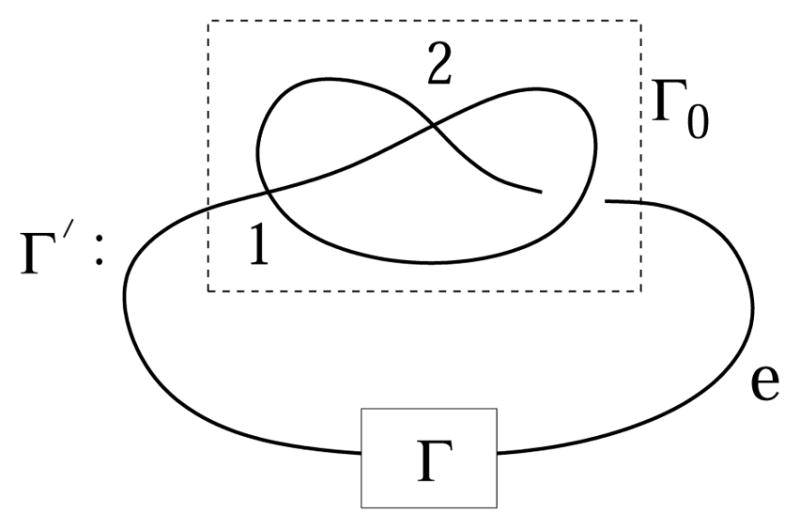
Connecting a pretzel
Lemma 14
Let Γ′ be obtained from Γ by connecting a pretzel. Suppose gr(Γ) = [m, n] for non-negative integers m and n (m ≤ n).
If there is a minimum genus embedding of Γ such that the two boundary curves tracing edge e belong to the same boundary component, then gr(Γ′) = [m, n + 1]. Otherwise gr(Γ′) = [m + 1, n + 1].
Proof
In Figure 9, the boundary curves corresponding to all possible connections at vertices of Γ0 are depicted in (A) through (D). The number of boundary components are 3 for (A) and (C), and 2 for (B) and (D). In (E) and (F), the situations of how they are connected are schematically depicted, respectively. The Figure (E) represents (A) and (C), and (F) represents (B) and (D).
Figure 9.
Boundary curves for 1212
Suppose Γ satisfies the condition that for all ribbon graphs of Γ, the two boundary curves tracing edge e belong to two distinct boundary components. Consider a ribbon graph F for Γ with genus g ∈ gr(Γ). For each ribbon graph F0 in (A) through (D) of Γ0 in Figure 9, we obtain a ribbon graph F′ of Γ′ by connecting corresponding boundaries of the ribbon graphs for Γ0 and Γ. If the connection of the boundary curves of a ribbon graph F0 of Γ0 is as in Figure 9(E), then the two curves tracing e become connected, and there is an additional component indicated by a small circle in the middle of (E). So the number of boundary components remains unchanged, and the number of vertices increases by 2. Hence g(F′) = g + 1, and g + 1 is an element of gr(Γ′). If the connection of the boundary curves of a ribbon graph F0 of Γ0 is as in Figure 9(F), then again the number of boundary curves of the ribbon graph for Γ′ remains the same as F, and the number of vertices increases by 2, so that g(F′) = g + 1, hence g + 1 is an element of gr(Γ′). Therefore gr(Γ) = [m + 1, n + 1].
Suppose Γ satisfies the condition that for some ribbon graphs of Γ, the two boundary curves tracing edge e belong to the same boundary component. Suppose that the connection of the boundary curves of a ribbon graph F0 of Γ0 is as in Figure 9(E). If the boundary component of a ribbon graph F for Γ tracing e is connected, then it becomes disconnected after connecting a pretzel and there is an additional component in F′. Therefore the number of boundary components increases by 2, and the number of vertices increases by 2. Hence g(F′) = g, and g is an element of gr(Γ′). If the boundary component of F for Γ tracing e is disconnected, then the number of boundary components remain unchanged, and the number of vertices increases by 2. Hence in this case g(F′) = g + 1.
If the connection of the boundary curves of a ribbon graph F0 of Γ0 is as in Figure 9(F), then the number of boundary components of the ribbon graph for Γ′ remains the same as that of F. In this case the number of vertices increases by 2, so g(F ′) = g + 1, and g + 1 is an element of gr(Γ′). Therefore gr(Γ) = [m, n + 1] or [m + 1, n + 1]. We note that the genus range of Γ′ is [m, n + 1] if and only if there exists a ribbon surface F with the minimum genus m such that e is traced by a single boundary component.
As to the condition (i) in the proof of Lemma 14, we note the following.
Lemma 15
Let Γ be a planar graph and e be an edge in Γ. Then for all ribbon graphs of Γ, there are two distinct boundary components that trace e.
Proof
Fix a planar diagram of Γ, still denoted by Γ. The closure of a topological, thin neighborhood of Γ in the plane determines a ribbon graph F. Each boundary curve of F corresponds to a region of the complement of F (a connected component of ℝ2 \ F) in the plane. In this construction, the connection of boundary curves at every vertex has the form in Figure 3(A). We assign checker-board “black” and “white” coloring to these regions (there is one, see [16] for example) such that regions bordering the same edge have distinct colors. The corresponding boundary curves of F inherit this coloring. Hence every edge is traced by boundary components of two distinct colors. Let B and W be (disjoint, non-empty) families of boundary curves colored black and white, respectively. Any ribbon graph F ′ of Γ is obtained from F by changing boundary connections at some vertices. When we change the boundary connection at a vertex v, two diagonal boundary curves of the same color become connected, see Figure 3 (A) and (C). The connected curves inherit the color, each component of the boundary curves is colored black or white after the change, and every edge of Γ is traced by two boundary components, one white and one black.
3 Realizations of Genus Ranges
Guided by observations made from computer calculations (Table 1), in this section we prove general statements on the non-existence (Section 3.1) and existence (Section 3.2) of various genus ranges. We recall again that all graphs are transversely connected 4-regular rigid vertex graphs.
3.1 Genus ranges that do not arise
In what follows, all graphs refer to transversely connected 4-regular rigid vertex graphs.
Lemma 16
For any positive integer n, there is no graph with 2n − 1 vertices with genus range [0, n].
Proof
Suppose there is such a graph Γ. Since its genus range contains 0, Γ is planar. By Lemma 15, every ribbon graph of Γ has more than one boundary component, and therefore, the genus cannot be n by Lemma 3.
The lemma below uses arguments and methods similar to those in [18].
Lemma 17
For every graph there is a ribbon graph with more than one boundary component.
Proof
Let Γ be a graph with k vertices. Starting from one vertex, we enumerate the edges of Γ along the transversal from 1 to 2k. Since the transversal consists of an Eulerian path in which two consecutive edges are not neighbors, every vertex in Γ is incident to two even numbered edges and two odd numbered edges. Moreover, the odd numbered (similarly, even numbered) edges incident to a common vertex are neighbors to each other. Let G be the subgraph of Γ that is induced by the odd numbered edges. This graph consists of k vertices and k edges, so it is a collection of cycles. For any cycle c of G, there is a choice of connection such that c is a boundary component of a ribbon graph F. Since this component traces edges only in G, the ribbon graph F must contain boundary components that trace the edges not in G, hence, F has more than one component.
The lemma immediately implies the following.
Lemma 18
For any positive integer n, there is no graph with 2n − 1 vertices with genus range {n}.
3.2 Genus ranges that do arise
Proposition 19
For any integer m ≥ 0, there exists an integer n such that {m} is a genus range in 𝒢ℛn.
Proof
Let Γm be the graph obtained by connecting m copies of Γ0 in the boxes B1, …, Bm as depicted by solid line in Figure 10, where Γ0 is the graph depicted in the upper half of Figure 8 that corresponds to the word 1212. This is obtained from copies of Γ0 by repeated application of cross sum of Definition 11. Recall that Γ0 has the genus range {1}. By Lemma 12, Γm has the genus range {m}.
Figure 10.
Repeating cross sum
The following provides a characterization of graphs with genus range {0}, giving an answer to Problem 1 (b) for this range.
Proposition 20
A double-occurrence word w is loop-nested if and only if gr(Γw) = {0}.
Proof
Corollary 9 implies that if w is loop-nested then gr(Γw) = {0}. The converse follows from a known characterization of signed double-occurrence words corresponding to closed normal planar curves (Theorem 1 of [7]).
In Figure 11, all possibilities of global connections of local arcs for a neighborhood of a vertex corresponding to Figure 3(A) are depicted in the top row, and in the middle row, the global connections after the change of connection as in Figure 3(C) are depicted. In the bottom row, the change of the number of boundary components associated with a connection change is listed. This list is used in the proofs below.
Proposition 21
The graph corresponding to any word obtained from w = 12 ⋯ n12 ⋯ n, for an odd integer n, by loop nesting has the genus range [0, 1].
Proof
First we show that the graph Γn corresponding to a word w = 12 ⋯ n12 ⋯ n has genus range {0, 1}. We start with the planar diagram depicted in Figure 12. Boundary curves of the ribbon graph obtained as a neighborhood of Γn are depicted by dotted lines. When the connection of one vertex (the vertex 1 in Figure 13 left) is changed, both pairs of diagonal curves are connected from two components to one (see Figure 11(f)). Hence the number of boundary components reduce by 2, and the genus increases from 0 to 1 by Lemma 3.
Figure 12.
Graphs for words of the form 12 ⋯ n12 ⋯ n
Figure 13.
Changing connections for repeat word graphs
After the change at the vertex 1, the boundary connection at every other vertex 2 through n is as depicted in Figure 11(h). Hence the number of the boundary components does not change by changing the boundary connections. After the second change of the boundary connection at the vertex i, the connection at every vertex remains the same as in Figure 11(h). This property holds for odd n. In Figure 13 middle and right, changes are made at vertices i = 2 and 3, respectively, after the change at the vertex 1.
The statement follows from Lemma 7.
Conjecture 22
Any double-occurrence word whose corresponding graph has genus range [0, 1] is obtained from the word w = 12 ⋯ n12 ⋯ n for an odd integer n by loop nesting.
Proposition 23
For any integer n > 1, there exists a graph Γ of 2n vertices with gr(Γ) = [0, n].
Proof
Computer calculations in Table 1 show that there is a unique graph of 4 vertices corresponding to 12314324 that has genus range {0, 1, 2}. In Figure 14, a graph P3 is depicted that has the genus range {0, 1, 2, 3}. To show this, we start with the planar diagram as depicted. We consider the ribbon graph that is a thin neighborhood of this planar diagram. For this ribbon graph, the boundary connection at every vertex appears as type (A) in Figure 3. The genus of this ribbon graph is 0. Each region of the diagram corresponds to a boundary curve of the corresponding ribbon graph. Four of such boundary curves (out of total 8) are depicted by dotted lines in the figure, for the regions labeled by a1, a2, b1, and b2.
Figure 14.
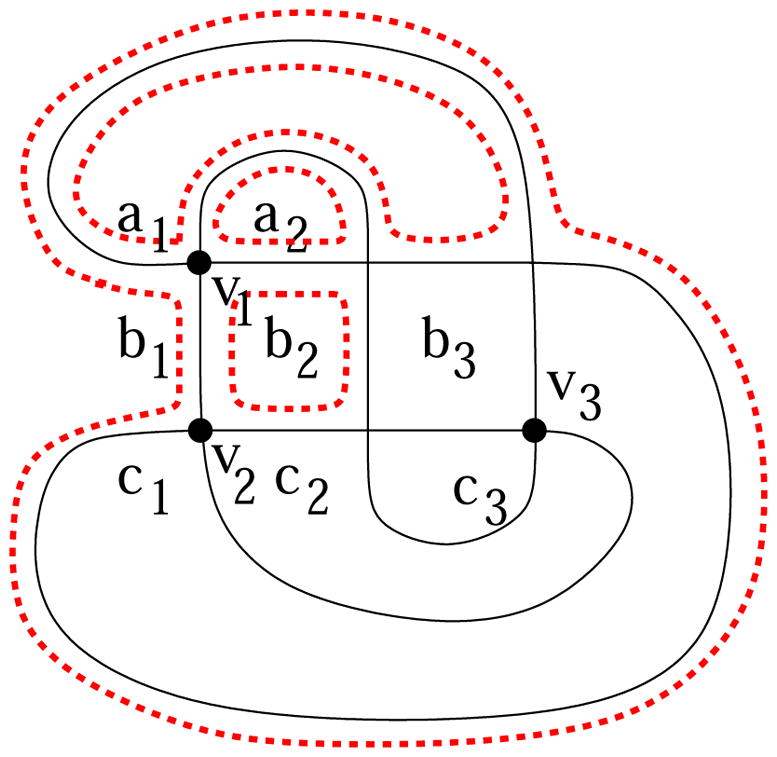
Proof for P3
We change the boundary connection at the vertex labeled by v1 from type (A) in Figure 3 to type (C), where the connection is as indicated in Figure 11(f). Then as Figure 11(f) indicates, the curves a1 and b2, a2 and b1, are connected, respectively, reducing the number of boundary components by 2. This causes the increase of the genus of the new ribbon graph by 1 by Lemma 3, so that the new surface has genus 1. After the connection change at v1, the boundary connection at v2 remains as in Figure 11(f), since the regions b1, b2, c1, c2 are bounded by distinct curves. Thus by repeating this process with vertices v2 and v3, we obtain ribbon graphs of genus 2 and 3, respectively. The number of boundary curves after performing the changes at v1, v2 and v3 is 2. The two components can be seen as a checkerboard coloring of the regions, and the two boundary curves near every edge belong to distinct components (cf. Lemma 15). This shows that the genus range for this graph is {0, 1, 2, 3}.
Next we describe the graph Pn for n > 3 as the combination of three subgraphs indicated in Figure 17 as follows. If n is odd, then the subgraph in the box (X) in Figure 17 is as depicted in Figure 15(odd), and if n is even, it is as depicted in Figure 15(even), respectively. The middle part in the box (Y) is as depicted in Figure 17. The subgraph in box (Z) in Figure 17 is either (down) or (up) of Figure 16, and the choice is determined by the number of vertices of Pn. Specifically, for integers k, Pn has the following patterns in boxes (X) and (Z) in Figure 17, respectively: If n = 4k, 4k+1, 4k+2, 4k+3, respectively, the box (X) and (Z) are filled with (even) and (down), (odd) and (up), (even) and (up), (odd) and (down), respectively. Examples for n = 6 (even, up) and 7 (odd, down) are depicted in Figure 18 and 19, respectively.
Figure 17.
Inductive construction of Pn
Figure 15.
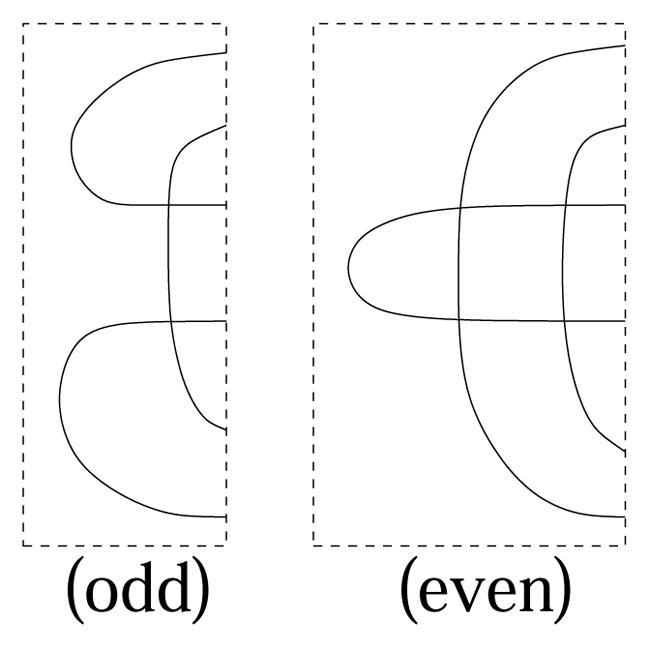
Box (X)
Figure 16.
Box (Z)
Figure 18.
P6
Figure 19.
P7
We generalize the argument for P3 to Pn inductively. We start with the ribbon graph that is a thin neighborhood of the planar diagram as described in Figure 17, where the boundary connection at every vertex is of type (A) in Figure 3. The connection of boundary curves is as Figure 11(f) at every vertex. We successively change boundary connections from type (A) to type (C) at a subset of vertices we describe below. With every such change, the number of boundary components of the corresponding ribbon graph reduces by 2, and hence the genus increases by 1. We start by changing the boundary connections for the vertices in the subgraph in box (X). For n odd, we change the boundary connection at vertices v1 and v2 in Figure 20(odd), and for n even, at vertices v1, v2 and v3 in Figure 20(even). The checkerboard coloring in Figure 20 indicates that the boundary curves of the regions of the same shading are connected.
Figure 20.
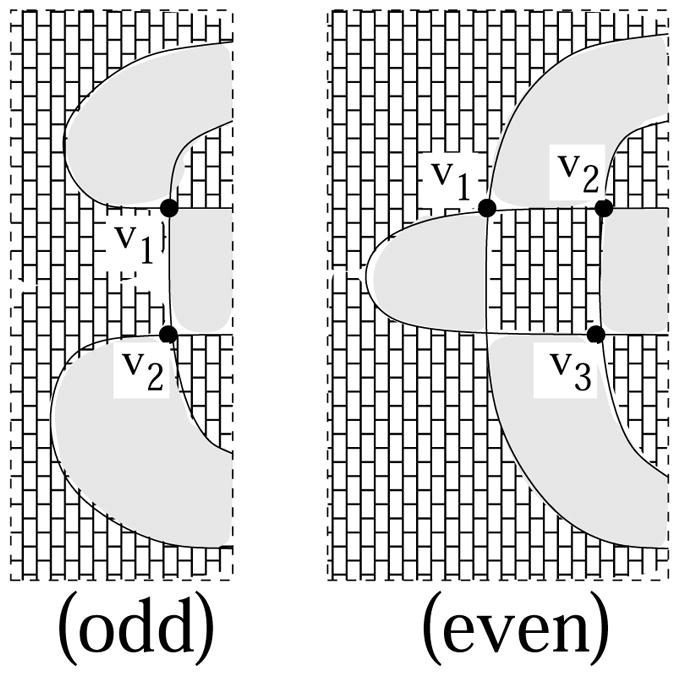
Shading (X)
Next we proceed to box (Y) inductively. In Figure 21, after the changes of the boundary connections at vertices vi and vi+1 in this order, the boundary curves are connected for the curves of the regions of the same shading in Figure 21. Note that the boundary curves of the four regions (a) through (d) in the figure belong to distinct components. Hence the connection changes at the vertices vi+2 and vi+3 in this order connects the curves (a) and (c), (b) and (d) to those two curves corresponding to the two shadings, respectively. Inductively, by changing boundary connections in all thickened vertices in Figure 17 box (Y), all curves bounding the regions in box (Y) are connected to two boundary components. The two components are indicated by the checkerboard shading.
Figure 21.
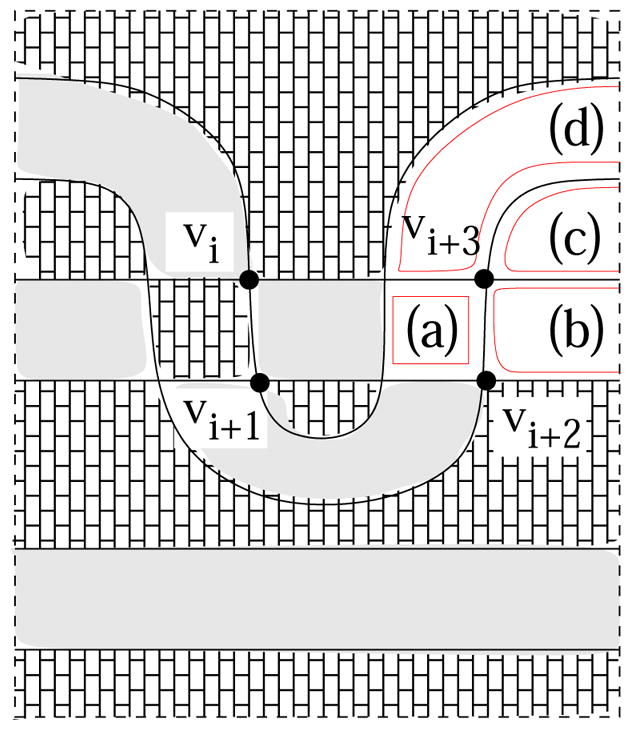
Shading (Y)
We complete the induction in box (Z) as indicated in Figure 3.2. The last sequences of vertices where the boundary connections are changed from type (A) to (C) are depicted in the figure for each case (up) and (down) of Figure 16.
Proposition 24
For any integer n > 1, there exists a graph Γ of 2n + 1 vertices with gr(Γ) = [0, n].
Proof
This follows from Proposition 23 and Lemma 10.
Next, we find the genus range of a family of graphs called the tangled cords. Furthermore, in view of Problem 1, we prove that for all odd n the maximum genus range is achieved by the tangled cord with n vertices. The analysis of the genus range in this case uses a technique of addition and removal of a vertex, described in Section 1.2.3.
Definition 25
A tangled cord [6] with n vertices and 2n edges, denoted Tn, is a special type of graphs of the form illustrated in Figure 23.
Figure 23.
Tangled cord Tn
The graph Tn corresponds to the double-occurrence word
Specifically, T1, T2 and T3 correspond to 11, 1212, and 121323 respectively, and the double-occurrence word of Tn+1 is obtained from the double-occurrence word of Tn by replacing the last letter (n) by the subword (n + 1)n(n + 1). Figure 23 shows the structure of the tangled cord. For vertices and edges of Tn, we establish the following notation for the rest of the section. The edges of Tn are enumerated as e1, …, e2n as they are encountered by the transverse path given by the double-occurrence word, in this order. The adjacent edges to each vertex are listed below, in the cyclic order around the vertex, as follows.
By construction, Tn+1 is obtained from Tn by addition of a vertex vn+1 by crossing e2n−1 and e2n as in Figure 23, with the cyclic order e2n+1, e2n−1, e2n, e2n−2 at vn+1.
The tangled cord Tn was introduced in [6] as a graph that provided a tight upper bound on the number of Hamiltonian polygonal paths (paths in which consecutive edges are neighbors with respect to their common incidence vertex visiting every vertex exactly once) over all graphs of the same number of vertices.
We prove that for each Tn, if F is a ribbon graph for Tn then it has either 1 or 3 boundary components (if n is odd) or it has 2 or 4 boundary components (if n is even). First we prove the following lemma:
Lemma 26
Let F be a ribbon graph for Tn (n ≥ 2) and suppose B is the set of boundary components that trace edges e2n−1 and e2n. Then every edge of Tn is traced by a curve in B.
Proof
We use the following notation: for any set E of edges, let B(E) be the set of boundary components of the ribbon graph F that trace at least one edge in E. So B in the statement is written as B({e2n−1, e2n}). Observe that B has at most four elements as there are at most four boundary components tracing two edges. Edges e2n−1 and e2n in Tn are not neighbors, but they are consecutive edges of the transverse path defining Tn. Hence all boundary components tracing e2n−1 and e2n (which are at most four) must trace their neighboring edges e2n−2 and e2n−3 (see Figure 3(A) or (C)). Therefore B({e2n, e2n−1, e2n−2, e2n−3}) = B. But then edges e2n−1 and e2n−2 are consecutive edges of the transverse path at vertex vn−1 and so, all boundary components that trace e2n−1 and e2n−2 must also trace their neighboring edges at vn−1, that is, edges e2n−4 and e2n−5. So B({e2n, …, e2n−5}) = B.
Inductively, if B({e2n, …, e2i, e2i−1}) = B, then all edges incident to vertices vn, vn−1, …, vi+1 (i ≥ 2) are traced with boundary components from B. The edges e2i+1 and e2i are not neighbors and are both incident to vi, therefore the boundary components that trace e2i+1 and e2i, also trace e2i−2 and e2i−3. Hence B({e2n, e2n−1, …, e2i−2, e2i−3}) = B. If i = 2 we obtain that B(E) = B where E is the set of all edges of Tn.
As a consequence of Lemma 26, and the fact that the parity of the number of boundary components of the ribbon graph must match the parity of the vertices from Lemma 3, we have that if n is even then any ribbon graph of Tn has 2 or 4 boundary components, and if n is odd, then any ribbon graph of Tn has 1 or 3 boundary components. In the following we observe that all these situations appear.
Lemma 27
For every odd number n > 2 there is a ribbon graph of Tn with three boundary components.
Proof
This lemma is a corollary of Lemma 18 (and its proof) where it is observed that for every graph there is a ribbon graph with more than one boundary component.
Lemma 28
For every odd number n > 2, there is a ribbon graph F of Tn with a single boundary component tracing edges e2n and e2n−1 whose global connection is as in Figure 5(f).
Proof
Since n is odd, the number of boundary components are either 1 or 3. The global connection of the boundary component in Figure 5(f) implies that the four possible boundary components tracing edges e2n and e2n−1 (indicated in Figure 24(a) with 1 through 4) are connected such that 1 is connected to 2, 2 connected to 3. If 3 is connected to 1, there would be two boundary components, hence 3 must be connected to 4, and back to 1. Therefore we only need to show that there is a ribbon graph where 1 is connected to 2 and 2 to 3. Suppose a ribbon graph corresponding to a fixed planar diagram in Figure 24(a) has boundary curves connected as type (A) of Figure 3 at vertices vn, vn−1, …, v5 and also at vertex v1. Then following the indicated arrows in Figure 24(a) the boundary curves visit vertices:
| (*) |
| (**) |
Figure 24.
Connections of four boundary components in Tn
It follows that the two curves “meet” at every other vertex they visit (with indices changing in gaps of 3), but if the two curves “meet” at vi, one of the curves traces edge e2i and the other traces e2i+1. There are three possibilities for the vertex of the smallest index (greater than 2) for (*) and (**) to “meet”: at vertex v3, vertex v4 and at vertex v5 respectively. These situations are depicted in Figure 24(b–d, respectively) where the blue component indicates (*) and the red indicates (**).
The curves “meet” at vertex v3 when n = 6k + 3 (Figure 24(b)), in which case we consider the ribbon graph where the boundary curves are connected at vertex v2 in type (C) in Figure 3, and at all other vertices the connections are of type (A). The curves “meet” at vertex v4 when n = 6k+1 (Figure 24(c)), in which case we consider the ribbon graph where the boundary curves are connected at vertex v4 in type (C), and at all other vertices the connections are of type (A). The curves “meet” at vertex v5 when n = 6k +5 (Figure 24(d)), in which case we consider the ribbon graph where the boundary curves are connected at vertex v2 and v3 in type (C), and at all other vertices the connections are of type (A). In all three cases we note that: (i) the (blue) boundary curve 1 that traces e3 to v1 and then e2n, continues to “join” with boundary curve 2 and (ii) the (red) boundary curve 2 that traces the even edges e6, e8, e10, …, e2n−2, and then e2n−1 “joins” with boundary curve 3 (Figure 24(a)). Since in all three cases situations (i) and (ii) appear, the global connection of the boundary components at edges e2n−1 and e2n are the same as in Figure 5(f).
The following proposition gives the final result about the genus range of Tn.
Proposition 29
Let Tn be the tangled cord with n = 2k or 2k − 1 vertices. Then gr(Tn) = [k − 1, k].
Proof
Recall that there are at most 4 boundary components by Lemma 26. By Lemmas 27, 28 for every odd n, there is a ribbon graph for Tn with one boundary component and there is a ribbon graph for Tn with three boundary components. We need to prove, for n even, that there are ribbon graphs with 2 and 4 boundary components. The graph Tn+1 is obtained from Tn by vertex addition by crossing e2n−1 and e2n. Suppose n ≥ 3 is odd. Then Tn has ribbon graphs with one and three components. By Lemma 6(iii) by adding vertex vn+1 through crossing e2n−1 and e2n the three-component ribbon graph for Tn becomes a ribbon graph with two boundary components for Tn+1. By Lemma 28 there is a ribbon graph for Tn with a single boundary component, in which the global boundary connection traces edges e2n−1 and e2n as in Figure 5(f). Then after adding vertex vn+1 by crossing e2n−1 and e2n, this ribbon graph becomes a ribbon graph with four boundary components for Tn+1. By Lemma 3 the result follows.
4 Towards Characterizing Genus Ranges
In this section we state and prove the main theorem on genus ranges of transversely connected 4-regular rigid vertex graphs. First we set the following notation.
Definition 30
We define the consecutive power set of {0, 1, …, n} for a positive integer n, denoted by 𝒞℘(n), to be the set of all consecutive positive integers: 𝒞℘(n) = { [a, b] | 0 ≤ a ≤ b ≤ n}.
Corollary 31
For any n ∈ ℕ, we have 𝒢ℛ2n−1, 𝒢ℛ2n ⊂ 𝒞℘(n).
Proof
This follows from Lemma 4, and Lemma 3 since b(F) ≥ 0.
To describe the genus ranges we can realize, we define the following integer sequence. For a positive integer n, define , and ψn = 3Kn +Ln. For n = 100, for example, Kn = 14, Ln = 1 and ψn = 43. These numbers allow us to state the main theorem in the paper.
Theorem 32
For any n > 1, n ∈ ℕ, 𝒢ℛ2n contains the set 𝒞℘(n) \ {[h, h] | ψ2n < h ≤ n}.
For any n ∈ ℕ, 𝒢ℛ2n−1 contains the set 𝒞℘(n) \ {[0, n], [h, h] | ψ2n−1 < h ≤ n}.
For any n ∈ ℕ, [0, n], [n, n] ∉ 𝒢ℛ2n−1.
Proof
The part (iii) is a restatement of Lemmas 16 and 18. We show (i) and (ii) by induction and constructions. Computer calculations in Table 1 show that the statements hold for n = 1, 2, 3 for 𝒢ℛ2n−1 and n = 2, 3 for 𝒢ℛ2n.
First we focus on sets [a, b] with a < b. Assume for induction that 𝒢ℛ2k−1 contains all sets [a, b] ∈ 𝒞℘(k), where a < b ≤ k, excluding [0, k]. By Lemma 10, all these sets are contained in 𝒢ℛ2k. Proposition 23 implies that [0, k] is contained in 𝒢ℛ2k and so is in 𝒢ℛ2k+1. Hence all sets [a, b] ∈ 𝒞℘(k), where a < b ≤ k for n ≤ k, are contained in 𝒢ℛ2k and 𝒢ℛ2k+1.
Assume next that 𝒢ℛ2k contains all sets [a, b] ∈ 𝒞℘(k), where a < b ≤ k, and also that 𝒢ℛ2k−1 contains all sets [a, b] ∈ 𝒞℘(k), where a < b ≤ k, excluding [0, k]. By Lemma 10, all [a, b] ∈ 𝒞℘(k), where a < b ≤ k, are contained in 𝒢ℛ2k+1. We show that 𝒢ℛ2k+1 contains all [a, b] ∈ 𝒞℘(k + 1), where a < b ≤ k + 1, excluding [0, k + 1]. Among these wanted, the following have not been covered by the induction assumption: [h, k + 1] for h = 1, …, k and [0, k]. There is a graph with 2k + 1 vertices and genus range [0, k] by Proposition 24. Thus we construct a graph Γ with |Γ| = 2k + 1 and gr(Γ) = [h, k + 1] for h = 1, …, k. Let T2h+1 be the tangled cord of size 2h + 1, which has genus range [h, h + 1] by Proposition 29. Let F be a ribbon graph of T2h+1 with genus h, and hence with 3 boundary components. We claim that there is an edge that is traced by a single component. Assume otherwise, that every edge is traced by distinct components. Since 4 boundary curves meet at every vertex, and there are 3 boundary components, at least two curves at each vertex belong to the same component.
In Figure 11, there are two possibilities with 3 boundary components at the top row, cases (e) and (h). Case (e) contains an edge traced by a single component, hence it is excluded by assumption. After the connection change (Figure 11 (h) bottom), the total number of boundary components stays as 3. A similar inspection shows that if both diagonal components belong to the same components (and 2 components meet at the vertex, Figure 11 (j)), then the connection change would separate these components into 4 components, which is impossible with T2h+1 by Proposition 29. Therefore if every edge is traced by distinct components, then at every vertex the situation must be as in Figure 11 (h). But then, a connection change at any vertex does not change the number of components 3, which again contradicts Proposition 29 that the genus range of T2h+1 is not a singleton. Hence there exists an edge e that is traced by a single component.
In Lemma 14, let Γ = T2h+1 with the choice of an edge e that is traced by a single component for some ribbon graph F as found above. By (the proof of) Lemma 14, the genus range of the graph Γ′ obtained by connecting a pretzel along the edge e from Γ has genus range [h, h+2] and has size 2h+3. The edge connection of Γ0 that gives rise to the genus h for Γ′ is as depicted in Figure 9(E). Hence either of the edges connecting Γ and Γ0 is traced by a single boundary component for the ribbon graph resulted from these surfaces for Γ and Γ0. Inductively, by taking this graph Γ′ as a new Γ, and by repeating this process (k–h) times, we obtain a graph with genus range [h, h+1+(k−h)] = [h, k+1] and size (2h + 1) + 2(k − h) = 2k + 1 as desired.
We analyze the case [a, a]. Computer calculation shows that there is a unique graph Γ6 with genus range [3, 3] among all 6 vertex graphs. The graph Γ6 is represented by 123245153646. Let Γ(K, L) be the graph obtained by taking cross sums of K copies of Γ6 and L copies of Γ0 (represented by the word 1212). Then the number of vertices of Γ(K, L) is 7K + 3L − 1. Its genus range is [ψ, ψ] where ψ = 3K + L. The number of vertices of the graph Γ(K − 1, L+ 2) is one less than that of Γ(K, L) and its genus range is [ψ−1, ψ −1]. If K = 0, the number of vertices of the graph Γ(0, L−1) is two less than that of Γ(0, L) and its genus range is [ψ−1, ψ−1]. For n < 6, the statement follows from computer calculation (Table 1). For n ≥ 6, the genus range of the graph Γ(Kn, Ln) is [ψn, ψn], and theorem follows by considering Γ(K, L) with K ≤ Kn as above and applying Corollary 10.
Conjecture 33
For any m ∈ ℕ, there is an integer Ψm ≥ ψm such that
This means that there is no gap along the diagonal (see Figure 25). For small values of m ≤ 20, the conjecture holds with Ψm = ψm for m = 1, …, 7, 9, 13. At this time we are not able to determine if [5, 5] is in 𝒢ℛm for m = 10, 11, [6, 6] for m = 12, [7, 7] for m = 14, 15, [8, 8] for m = 16, 17, 18, and [9, 9] for m = 18, 19. The conjecture is true if there is only one unknown entry, and therefore, the conjecture holds for all m ≤ 20 except m = 18, and m = 18 is the smallest number for which we do not know if the conjecture holds. If one finds [8, 8] ∉ 𝒢ℛ18 but [9, 9] ∈ 𝒢ℛ18, then this will provide a counterexample. For n = 100, for example, we do not know if [h, h] ∈ 𝒢ℛ100 for h = 43, …, 50. We know that [4, 4] is not in 𝒢ℛ8 only by computer calculations in Table 1 searching through all graphs with 8 vertices.
Figure 25.
Diagram representing the conjecture
The situation for graphs with n vertices is depicted in Figure 25. Dots with the coordinates (a, b) represents the genus range [a, b]. The black dots represent that we have proved that there exists a graph with the corresponding genus range. Unmarked lattice points represent that there is no graph with the corresponding genus range due to the Euler characteristic formula. The white dots represent that we have proved, in this paper, that there are no graphs with such genus ranges. The red dots with question marks represent that these upper diagonal ranges remain unknown, beyond the number ψn we provided.
5 Concluding Remarks
For transversely connected 4-regular rigid vertex graphs, we considered the orientable genus range, that are genera of cellular embeddings. Some ranges are realized by using specific families of graphs, and others by some operations applied on graphs of smaller sizes. A few ranges are shown to be not realized as genus range. We identify particular intervals and singletons [h, h] that are unknown to be genus ranges. An interesting open question is whether these in fact can be realized.
In Figure 26(right), we note that there are only 13 graphs among 65346 graphs of 8 vertices with genus range [0, 4]. In Proposition 23, we constructed graphs with 2n vertices with genus range [0, n], and these graphs seem to be very rare. Also we notice that among 7 vertex graphs, there are only 2 graphs with genus range [3, 3]. It is a curious fact that certain types of genus rages are very rare, and some are numerous. It may be of interest to determine the distributions of genus ranges.
Figure 26.
Histogram of genus range distributions for the number of graphs graphs with 7 and 8 vertices, with a given genus range
We conclude with comments on possible relations and applications to the studies on DNA assembly. A mathematical model using 4-regular rigid vertex graphs for DNA recombination processes was proposed and studied in [2, 3, 6]. The molecular structure in space at the exact moment of recombination is modeled by assembly graphs, and the assembled gene is modeled by Hamiltonian polygonal paths, paths that make “90° turn” at every rigid vertex, and visit every vertex exactly once. These polygonal paths have been also studied in graph theory as A-trails (for example, [1]). In [6], it was proved that the tangled cord, which achieves the maximal genus range for at least the graphs with odd number of vertices, has the largest number of Hamiltonian polygonal paths among all assembly graphs of the same number of vertices. If one follows a boundary curve of a ribbon graph at every vertex (see Figure 3), the consecutive edges traced by the boundary curve must be neighbors, so they form a polygonal path. Thus it is expected that smaller numbers of boundary components contribute to larger numbers of Hamiltonian polygonal paths. However, an explicit relationship between the genus range and the number of Hamiltonian polygonal paths is still unknown.
Figure 22.
Shading (Z)
Acknowledgments
We wish to thank F. Din-Houn Lau and Kylash Rajendran, Erica Flapan, Mauro Mauricio and Julian Gibbons for insightful discussions. We also thank Ryan Arredondo for pointing out errors in an earlier version and Paul Kainen for useful references and comments. DB is supported in part by EPSRC Grants EP/H0313671, EP/G0395851 and EP/J1075308, and thanks the LMS and the Leverhulme Research Grant RP2013-K-017. KV was supported by EP/G0395851 to DB. This research was partially supported by grants NSF CCF-1117254, and NIH 1R01GM109459.
Contributor Information
Dorothy Buck, Email: d.buck@imperial.ac.uk, Department of Mathematics, Imperial College London, London, England, UK.
Egor Dolzhenko, Email: egor.dolzhenko@gmail.com, Molecular and Computational Biology Section, University of Southern California, Los Angeles, California, U.S.A.
Nataša Jonoska, Email: jonoska@usf.edu, Department of Mathematics and Statistics, University of South Florida, Tampa, Florida, U.S.A.
Masahico Saito, Email: saito@usf.edu, Department of Mathematics and Statistics, University of South Florida, Tampa, Florida, U.S.A.
Karin Valencia, Email: karin.sasaki@embl.de, European Molecular Biology Laboratory, Heidelberg, Germany.
References
- 1.Andersen LD, Bouchet A, Jackson B. Orthogonal A-trails of 4-regular graphs embedded in surfaces of low genus. J of Combinatorial Theory, Series B. 1996;66:232–246. [Google Scholar]
- 2.Angeleska A, Jonoska N, Saito M. DNA recombination through assembly graphs. Discrete Applied Mathematics. 2009;157:3020–3037. [Google Scholar]
- 3.Angeleska A, Jonoska N, Saito M, Landweber LF. RNA-guided DNA assembly. Journal of Theoretical Biology. 2007;248(4):706–720. doi: 10.1016/j.jtbi.2007.06.007. [DOI] [PubMed] [Google Scholar]
- 4.Bar-Natan D. On the Vassiliev knot invariants. Topology. 1995;34(2):423–472. [Google Scholar]
- 5.Bhandari K, Dye HA, Kauffman LH. Lower bounds on virtual crossing number and minimal surface genus. The Mathematics of Knots (1) In: Markus B, Denis V, editors. Contributions in Mathematical and Computational Sciences. Springer; 2011. pp. 31–43. [Google Scholar]
- 6.Burns J, Dolzhenko E, Jonoska N, Muche T, Saito M. Polygonal Hamiltonian paths in rigid 4-regular graphs and DNA assembly. Discrete Applied Mathematics. 2011;161:1378–1394. [Google Scholar]
- 7.Cairns G, Elton DM. The planarity problem for signed Gauss words. J of Knot Theory and its Ramifications. 2011;2:359–367. [Google Scholar]
- 8.Cairns G, Elton DM. The planarity problem II. J of Knot Theory and its Ramification. 2011;5:137–144. [Google Scholar]
- 9.Carter JS. Classifying immersed curves. Proc Amer Math Soc. 1991;111(1):281–287. [Google Scholar]
- 10.Carter JS. personal communication. 2011.
- 11.Chmutov S. Generalized duality for graphs on surfaces and the signed Bollobs-Riordan polynomial. J Combin Theory Ser B. 2009;99(3):617–638. [Google Scholar]
- 12.Duke RA. The genus, regional number, and Betti number of a graph. Canad J Math. 1966;18:817–822. [Google Scholar]
- 13.Dye H, Kauffman LH. Minimal surface representations of virtual knots and links. Algebr Geom Topol. 2005;5:509–535. [Google Scholar]
- 14.Gross JL, Tucker TW. Topological graph theory. Dover Publications, Inc; Mineola, NY: 2001. [Google Scholar]
- 15.Jonoska N, Saito M. Boundary components of thickened graphs. Lecture Notes in Computer Science. 1960;2340:70–81. [Google Scholar]
- 16.Kauffman LH. Knots and physics. 3. Vol. 1. World Scientific Publishing Co., Inc; River Edge, NJ: 2001. Series on Knots and Everything. [Google Scholar]
- 17.Mohar B, Thomassen C. Graphs on Surfaces. The Johns Hopkins University Press; Baltimore: 2001. [Google Scholar]
- 18.Škoviera M, Širáň J. Oriented relative embeddings of graphs. Zastos Mat; Proceedings of the International Conference on Combinatorial Analysis and its Applications; Pokrzywna. 1985; 1987. pp. 589–597. [Google Scholar]




